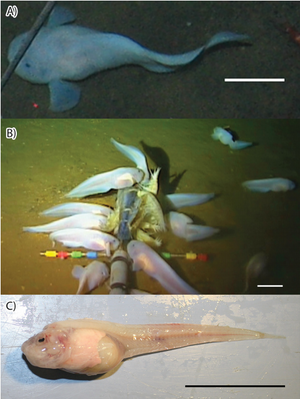Pseudoliparis swirei
| Pseudoliparis swirei | ||||||||||||
|---|---|---|---|---|---|---|---|---|---|---|---|---|

A) In-situ photograph of Pseudoliparis swirei at a depth of 6198 m, B) group at a depth of 7485 m, C) specimen brought on deck. The scale corresponds to 5 cm in each case. |
||||||||||||
| Systematics | ||||||||||||
|
||||||||||||
| Scientific name | ||||||||||||
| Pseudoliparis swirei | ||||||||||||
| Gerringer , Linley , Jamieson , Goetze & Drazen , 2017 |
Pseudoliparis swirei is a deep-sea fish from the family of the disc bellies (Liparidae). It lives in the Mariana Trench in the northwestern Pacific at very great depths and was only described in November 2017. The 37specimens examinedfor the initial description were caught at depths of 6,898 to 7,966 meters. There arevideo recordings of fish thatlooklike Pseudoliparis swirei from depths of 6198 to 8098 meters. According to current knowledge,this makes Pseudoliparis swirei the deepest species of fish. Only one specimen of Abyssobrotula galatheae was recovered at an even greater depth (8,370 meters in the Puerto Rico Trench ) - since the fish was already dead at the time it was caught, it is not known whether it lived at this depth.
features
The specimens of Pseudoliparis swirei examined for the first description had standard lengths of 8.7 to 22.6 cm and overall lengths of 9.5 to 23.7 cm. Like all disc bellies, the fish species has a tadpole-like, elongated body that is laterally flattened at the back and surrounded by a fin edge made of dorsal, caudal and anal fin that have grown together. The head is small and broad and rounded when viewed from the side. The head height corresponds roughly to the body height. The snout is blunt, the horizontally running, medium-sized mouth is slightly below and reaches under the eyes. Pseudoliparis swirei has only a single nostril on each side of the head (most fish have two on each side of the head), which is at the same level as the center of the eye. The teeth are simple, conical and sharp. They are arranged in 6 to 11 irregular rows on the maxillary and 7 to 13 in the lower jaw. Older specimens have more teeth in a row and more rows of teeth. The pharyngeal teeth are well developed, long and sharp. They sit on spherical tooth plates. With a diameter of 10% of the length of the head, the eyes are very small. The gill openings are small. They are completely above the base of the pectoral fin.
- Fin formula : dorsal 51–58, anal 43–49, pectoral 28–32, caudal 11–14
- Vertebra: 56-62
- Pyloric tubes : 5–9
Pseudoliparis swirei is rosy-whitish in color. The skin and the peritoneum are transparent so that internal organs (liver, stomach, pyloric tubes) and the trunk muscles are visible through the skin. The pyloric tubes are orange. Some of the larger specimens are dark on the head, but most specimens show no traces of pigmentation either outside or inside.
Naming
Pseudoliparis swirei was named in honor of Herbert Swire. He was an officer of the HMS Challenger , which circumnavigated the world from 1872 to 1876, about which he published records. The Mariana Trench was also explored during this expedition.
Way of life
Pseudoliparis swirei is only known from the Mariana Trench, where it is probably endemic . Some of the females examined contained eggs, larger ones from 5 to 9.4 mm in diameter and smaller ones half that size. The larger ones were always embedded in a matrix of smaller eggs. They are among the largest eggs among all real bony fish (Teleostei). Other females only had very small eggs, 0.7 to 1.4 mm in diameter. The fish caught and filmed for the first description were attracted to a bait and ate flea shrimp that were also attracted by the bait. Pseudoliparis swirei was no longer seen below a depth of 8100 meters . It is possible that fish are biochemically prevented from colonizing the deepest depths of the oceans because their osmoregulation fails at a depth of 8200 meters.
source
- Gerringer, ME, Linley, TD, Jamieson, AJ, Goetze, E. & Drazen, JC: Pseudoliparis swirei sp. nov .: A newly-discovered hadal snailfish (Scorpaeniformes: Liparidae) from the Mariana Trench. In: Zootaxa . tape 4358 , no. 1 , 2017, p. 161–177 , doi : 10.11646 / zootaxa.4358.1.7 (English).
Individual evidence
- ↑ National Geographic, November 30, 2017: New fish species sets record depth
- ↑ Yancey, P., Gerringer, M., Drazen, J., Rowden, A. & Jamieson, A .: Marine fish may be biochemically constrained from inhabiting the deepest ocean depths. In: Proceedings of the National Academy of Sciences . tape 111 , no. March 12 , 2014, p. 4461-5 , doi : 10.1073 / pnas.1322003111 (English).

